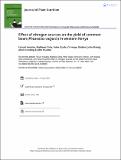| dc.contributor.author | Fanuel Kawaka, Mathews Dida, Peter Opala, Omwoyo Ombori, John Maingi, Alice Amoding, John Muoma | |
| dc.date.accessioned | 2020-08-12T07:05:16Z | |
| dc.date.available | 2020-08-12T07:05:16Z | |
| dc.date.issued | 2018-08-09 | |
| dc.identifier.uri | https://repository.maseno.ac.ke/handle/123456789/1993 | |
| dc.description.abstract | Depletion of soil nutrients due to continuous cultivation without adequate external fertilization is one of the challenges facing many smallholder farmers in western Kenya. This study was conducted to assess the effects of organic (water hyacinth compost), inorganic (urea) nitrogen (N) sources, and commercial Rhizobia inoculant on the yield of common bean (Phaseolus vulgaris) for two consecutive seasons in the short rains (2013) and long rains (2014). The experiments were laid out in a randomized complete block design and replicated four times. Triple superphosphate was applied to all treatments except those with compost to ensure that the soil had adequate phosphorus (P). Yellow and Rose coco bean varieties grown with urea and inoculated with commercial Rhizobia inoculant gave significantly higher yield of 382 kg ha−1 and 341 kg ha−1, respectively in the short rains (SR) season. In the long rains (LR … | en_US |
| dc.publisher | Taylor & Francis | en_US |
| dc.subject | inorganic, organic, rhizobia, smallholder, water hyacinth | en_US |
| dc.title | Effect of nitrogen sources on the yield of common bean (Phaseolus vulgaris) in western Kenya | en_US |
| dc.type | Article | en_US |

